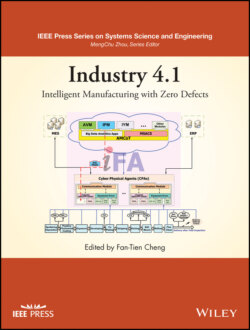Читать книгу Industry 4.1 - Группа авторов - Страница 22
1.2.1.3 Equipment Engineering System (EES)
ОглавлениеThe EES is defined as the physical implementation of the equipment engineering capabilities (EECs), which are applications that address specific areas of equipment engineering (EE), such as fault detection and classification (FDC), predictive maintenance (PdM), virtual metrology (VM), run‐to‐run (R2R) control, etc. [4, 5].
An EES framework is required to support the EECs [4]. Therefore, ISMT proposed an EES conceptual framework as shown in Figure 1.8 [4]. In the ISMT EES framework, three interfaces (Interface A, Interface B, and Interface C) are defined for different purposes. Interface A is an equipment data acquisition interface for getting more and better data from the equipment [20]. Interface B defines interfaces among EE applications and creates a connection between the MES and EES [24]. Interface C describes the external access to e‐diagnostics [16, 25].
Figure 1.8 The ISMT EES framework.
Source: Reprinted with permission from Ref. [14]; © 2010 IEEE.
As displayed in Figure 1.8, the ISMT EES framework posits all the EE applications (such as advanced process control (APC), OEE, FDC, PdM, VM, and others) outside the equipment. Those architectures are suitable for the applications of R2R‐type controls involving more than one piece of equipment. However, for self‐related equipment applications (e.g. FDC, PdM, and VM), such architectures heavily consume factory network bandwidth. Another disadvantage of those architectures is that all the data are sent to the same remote client for processing and monitoring, which may result in data overloading to the remote client and further impact the real‐time analysis efficiency. Additionally, if the remote client breaks down and lacks backup, the entire prognostics system is paralyzed [5].
To resolve the problems mentioned above, Su et al. [5] proposed another EES framework as shown in Figure 1.9. The proposed EES framework divides all the EE applications into three categories. The R2R‐type applications (e.g. APC and RM) are installed in the remote‐client side; the self‐related‐type applications (e.g. FDC, PdM, and VM) are plugged in the generic embedded devices (GEDs) [5] and distributed in each individual tools; the e‐diagnostics‐type applications are implemented in a remote client via Interface C for security considerations.
Figure 1.9 The proposed EES framework.
Source: Reprinted with permission from Ref. [14]; © 2010 IEEE.
Among the abovementioned EES applications, VM is an emerging technology [26]. VM is a method to conjecture the manufacturing quality of a process tool based on the data sensed from the process tool and without physical metrology operation [27].
Fab‐wide R2R control [28] is one of essential EES applications for semiconductor manufacturing. In general, a run can be a batch, lot, or an individual wafer. When lot‐to‐lot (L2L) control is applied, the promptness of each wafer’s VM result for the feedback and feedforward purposes will not be necessary. However, when wafer‐to‐wafer (W2W) control is adopted, obtaining the real‐time and on‐line VM result of each wafer in the feedback loop is essential.
